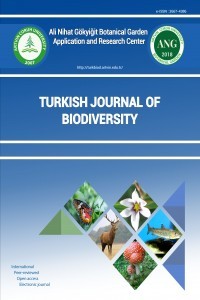Lota gölleri (Sivas, Türkiye) ve çevresinin florası
Bu çalışmada Lota Gölleri ve çevresi florası araştırılmıştır. Araştırman alanından, 2017-2018 yılları arasında 551 bitki örneği toplanmıştır. Araştırma sonucunda, 41 familya, 145 cinse ilişkin 256 takson kaydedilmiştir. Tanımlanan taksonların hepsi Spermatophyta bölümüne aittir. Angiospermae alt bölümüne ait taksonların 34’ü Monocotyledoneae, 222’si Dicotyledoneae sınıfında yer almaktadır. İçerdikleri takson sayısına göre en zengin ilk beş familya: Asteraceae 42, Fabaceae 30, Brassicaceae 25, Lamiaceae 25, Liliaceae 20. İçerdikleri takson sayısına göre en zengin ilk 5 cins: Astragalus 11, Salvia 9, Centaurea 7, Alyssum 6, Achillea 5. Tespit edilen taksonların fitocoğrafik bölgelere göre dağılımı şöyledir: 107’si (% 41,8) İran Turan elementi, 10’nu (% 3.9) Akdeniz elementi, 8’i (% 3,1) Avrupa Sibirya elementi, coğrafi bölgesi bilinmeyenler ve birden fazla bölgeyi tercih edenler ise 131 (%51,2)’dir. Taksonların 59’u (% 23) Türkiye için endemiktir.
Flora of Lota lakes (Sivas) and its surroundings
In this study, flora of Lake Lota and its environs were investigated. 551 Plant samples were collected between 2017 and 2018. As a result of the research, 41 families, 145 genera and 256 taxa were determined. All of the identified taxa belong to Spermatophyta. 34 of the taxa belonging to the Angiospermae subsection are Monocotyledoneae and 222 are classified as Dicotyledoneae. The richest first five families are Asteraceae 42 taxa, Fabaceae 30 taxa, Brassicaceae 25 taxa, Lamiaceae 25 taxa, Liliaceae 20 taxa. The richest five genera are Astragalus 11 taxa, Salvia 9 taxa, Centaurea 7 taxa, Alyssum 6 taxa, Achillea 5 taxa. The distribution of the taxa according to the phytogeographical regions was as follows: 107 (41.8%) Iranian Turanian, 10 (3.9%) Mediterranean elements, 8 (3.1%) European Siberian elements. 131 (51,2%) unknown. 59 taxa (23%) are endemic to Turkey.
___
- Akman Y, (1999). İklim ve Biyoiklim (Biyoiklim Metodları ve Türkiye İklimleri), Ankara: Kariyer Press, 350 p. (in Turkish)
- Akpulat HA, Çelik N (2002). Sivas-Sıcak Çermik Arası Florası. C.Ü. Fen Bilimleri Dergisi 1: 1-15. (in Turkish).
- Akpulat HA, Çelik N (2005). Flora of Gypsum Areas in Sivas in the eastern part of Cappadocia in Central Anatolia, Turkey. Journal of Arid Environments 61: 27-46.
- Aytaç Z, Akgül G, Ekici M (2012). A new species of Marrubium (Lamiaceae) from Central Anatolia, Turkey. Turkish Journal of Botany 36: 443-449.
- Celik N, Akpulat HA (2008). Achillea sivasica (Asteraceae: sec.Babounya (DC.) O. Hoffm.), a new species from Inter Anatolia, Turkey. Kew Bulletin 63 (3): 485-489.
- Celik N, Akpulat HA (2009). Tödürge Gölü (Sivas) ve Çevresi Florası, C.Ü. Fen Bilimleri Dergisi 30: 38-63. (in Turkish).
- Davis PH (1965-85). Flora of Turkey and the East Aegean Islands, Vol. 1-9, Edinburgh: Edinburgh University Press.
- Davis PH, Mill, RR, Tan K (1988). Flora of Turkey and the East Aegean Islands, Vol. 10, (Supplement 1), Edinburgh: Edinburgh University Press.
- Ekim T, Koyuncu M, Vural M, Duman H, Aytaç Z, Adıgüzel N (2000). Türkiye Bitkileri Kırmızı Kitabı, Ankara: Türkiye Tabiatı Koruma Derneği. (in Turkish).
- Güner A, Aslan S, Ekim T, Vural M, Babaç MT (eds) (2012). Türkiye Bitkileri Listesi (Damarlı Bitkiler). İstanbul: Nezahat Gökyiğit Botanik Bahçesi ve Flora Araştırmaları Derneği Yayını, 1290p.
- Güner A, Özhatay N, Ekim T, Başer KHC (2000). Flora of Turkey and the East Aegean Islands, Vol. 11, (Supplement-2), Edinburgh: Edinburgh University Press.
- Hamzaoğlu E (2012). A new species of Gypsophila and a new name for Silene (Caryophyllaceae) from Turkey. Turkish Journal of Botany 36: 135-139.
- Hamzaoğlu E, Aydoğdu M (1993). Hafik (Sivas) ve Çevresindeki Jipsli Toprakların Florası. Turkish Journal of Botany 19: 373-388.
- Hamzaoğlu E, Budak Ü, Aksoy A (2008). A New Species of Gagea Salisb. (Liliaceae) from Sivas (Central Anatolia, Turkey). Turkish Journal of Botany 32: 261-264.
- IUCN (2018). The IUCN Red List of Threatened Species. Version 2018-2. http://www.iucnredlist.org. Downloaded on 13 August 2018.
- Yayın Aralığı: Yılda 2 Sayı
- Başlangıç: 2018
- Yayıncı: Artvin Çoruh Üniversitesi
Sayıdaki Diğer Makaleler
Melahat ÖZCAN, Özgür EMİNAĞAOĞLU
Lota gölleri (Sivas, Türkiye) ve çevresinin florası
Kılıçkaya (Yusufeli, Artvin, Turkey) faunasına katkılar
Alanbaşı ve Bakırtepe (Yusufeli, Artvin, Turkey) ve çevresinin florası
Hayal AKYILDIRIM BEĞEN, Emrah YÜKSEL
Dereiçi köyü (Yusufeli, Artvin, Türkiye) ve çevresinin florası
